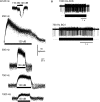Biomechanics of Third Window Syndrome
- PMID: 32982922
- PMCID: PMC7477384
- DOI: 10.3389/fneur.2020.00891
Biomechanics of Third Window Syndrome
Abstract
Third window syndrome describes a set of vestibular and auditory symptoms that arise when a pathological third mobile window is present in the bony labyrinth of the inner ear. The pathological mobile window (or windows) adds to the oval and round windows, disrupting normal auditory and vestibular function by altering biomechanics of the inner ear. The most commonly occurring third window syndrome arises from superior semicircular canal dehiscence (SSCD), where a section of bone overlying the superior semicircular canal is absent or thinned (near-dehiscence). The presentation of SSCD syndrome is well characterized by clinical audiological and vestibular tests. In this review, we describe how the third compliant window introduced by a SSCD alters the biomechanics of the inner ear and thereby leads to vestibular and auditory symptoms. Understanding the biomechanical origins of SSCD further provides insight into other third window syndromes and the potential of restoring function or reducing symptoms through surgical repair.
Keywords: air-bone gap; biomechanics; canal dehiscence; dizziness; superior semicircular canal dehiscence; third window; vertigo; vestibular.
Copyright © 2020 Iversen and Rabbitt.
Figures







Similar articles
-
Superior semicircular canal dehiscence syndrome.J Neurosurg. 2017 Dec;127(6):1268-1276. doi: 10.3171/2016.9.JNS16503. Epub 2017 Jan 13. J Neurosurg. 2017. PMID: 28084916 Review.
-
Clinical manifestations of superior semicircular canal dehiscence.Laryngoscope. 2005 Oct;115(10):1717-27. doi: 10.1097/01.mlg.0000178324.55729.b7. Laryngoscope. 2005. PMID: 16222184
-
New model of superior semicircular canal dehiscence with reversible diagnostic findings characteristic of patients with the disorder.Front Neurol. 2023 Jan 19;13:1035478. doi: 10.3389/fneur.2022.1035478. eCollection 2022. Front Neurol. 2023. PMID: 36742050 Free PMC article.
-
Superior semicircular canal dehiscence presenting as conductive hearing loss without vertigo.Otol Neurotol. 2004 Mar;25(2):121-9. doi: 10.1097/00129492-200403000-00007. Otol Neurotol. 2004. PMID: 15021770
-
[Superior-canal dehiscence syndrome].Ned Tijdschr Geneeskd. 2005 Jun 11;149(24):1320-5. Ned Tijdschr Geneeskd. 2005. PMID: 16008034 Review. Dutch.
Cited by
-
Rare Disorders of the Vestibular Labyrinth: of Zebras, Chameleons and Wolves in Sheep's Clothing.Laryngorhinootologie. 2021 Apr;100(S 01):S1-S40. doi: 10.1055/a-1349-7475. Epub 2021 Apr 30. Laryngorhinootologie. 2021. PMID: 34352900 Free PMC article. Review.
-
Impaired Vestibulo-Ocular Reflex on Video Head Impulse Test in Superior Canal Dehiscence: "Spontaneous Plugging" or Endolymphatic Flow Dissipation?Audiol Res. 2023 Oct 20;13(5):802-820. doi: 10.3390/audiolres13050071. Audiol Res. 2023. PMID: 37887852 Free PMC article.
-
Proposal for a Unitary Anatomo-Clinical and Radiological Classification of Third Mobile Window Abnormalities.Front Neurol. 2022 Jan 11;12:792545. doi: 10.3389/fneur.2021.792545. eCollection 2021. Front Neurol. 2022. PMID: 35087471 Free PMC article.
-
Cochlear Aqueduct Morphology in Superior Canal Dehiscence Syndrome.Audiol Res. 2023 May 15;13(3):367-377. doi: 10.3390/audiolres13030032. Audiol Res. 2023. PMID: 37218843 Free PMC article.
-
Predictors of non-primary auditory and vestibular symptom persistence following surgical repair of superior canal dehiscence syndrome.Front Neurol. 2024 Feb 26;15:1336627. doi: 10.3389/fneur.2024.1336627. eCollection 2024. Front Neurol. 2024. PMID: 38469592 Free PMC article.
References
Publication types
Grants and funding
LinkOut - more resources
Full Text Sources
Miscellaneous

